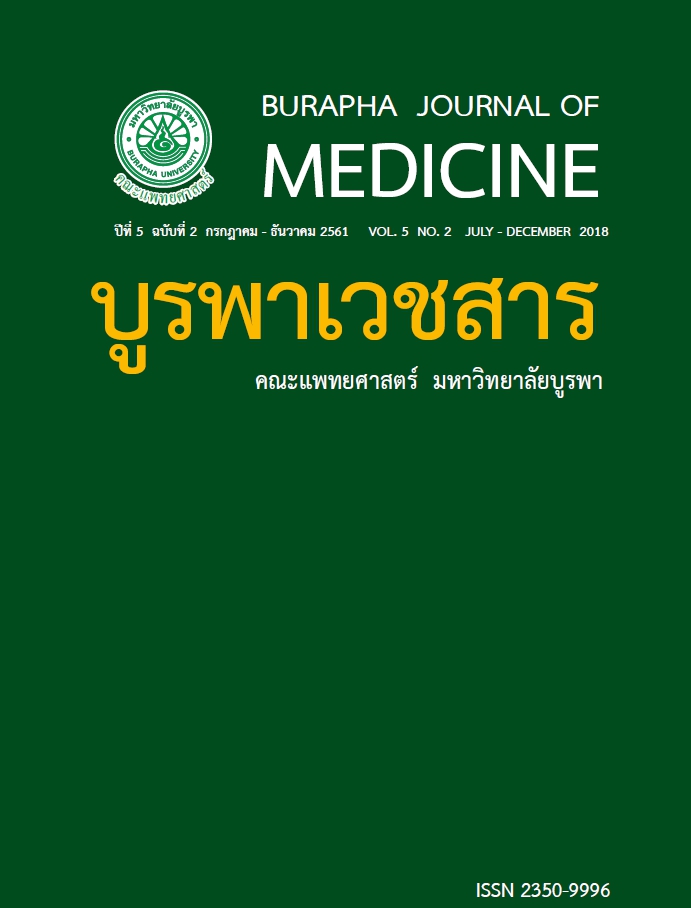Effect of hip positions on electromyographic activity of vastus medial oblique (VMO) and vastus lateralis (VL) during prone plank exercises
Main Article Content
บทคัดย่อ
Introduction Prone plank exercises improve overall core stability. However, decreased core
stability may cause knee injury, specifically anterior knee pain – for example, anterior cruciate
ligament injury, resulting in knee injuries caused by hip muscles, and general knee muscle
weakness [especially vastus medialis oblique (VMO) and vastus lateralis (VL)].
Materials and Methods A cross-sectional study was performed with 20 healthy volunteers
carrying out prone plank exercises, using surface electromyography to measure the subject’s
VMO and VL during hip adduction, hip abduction as well as with the hip in neutral position.
Results Prone plank exercises with different hip positions did not generate statistically significant
differences in VMO : VL ratios for both of the subject’s legs while in different hip positions
(p < 0.05). As well, VMO : VL ratios of both legs in all groups was not statistically different from
1.0 (p < 0.05).
Conclusions Prone plank exercises could promote muscle activation of VML : VO for both of
the subject’s legs.
Article Details
References
IM. Core Stability and Its Relationship to
Lower Extremity Function and Injury. J Am
Acad Orthop Surg. 2005; 5: 316-25.
2. Cedric DB, Roosen P, Willems T, Danneels
V, Bossche LV, Ridder RD. Is core stability
a risk factor for lower extremity injuries in
an athletic population? A systemic review.
Phys Ther Sport. 2018; 30: 48-56.
3. Czaprowski D, et al. Abdominal muscle
EMG-activity during bridge exercises on
stable and unstable surfaces. Sports Phys
Ther. 2014; 15: 162–68.
4. Ekstrom RA, Donatelli RA, Carp KC.
Electromyographic Analysis of Core
Trunk, Hip, and Thigh Muscles During 9
Rehabilitation Exercises. J Orthop Sports
Phys Ther. 2007; 37: 754-62
5. Boling M, Padua D, Blackburn JT, Petschauer
M, Hirth C. Hip Adduction Does not Affect
VMO EMG Amplitude or VMO:VL Ratios
During a Dynamic Squat Exercise. J Sport
Rehabil. 2006; 15: 195-205
6. Kim H, Song CH. Comparison of the VMO/
VL EMG Ratio and Onset Timing of VMO
Relative to VL in Subjects with and without
Patellofemoral Pain Syndrome. J Phys Ther
Sci. 2012; 24: 1315–317.
7. Staudenmann D, Roeleveld K, Stegeman
DF, Van Dieen JH. Methodological aspects
of SEMG recordings for force estimation--a
tutorial and review. J Electromyogr Kinesiol.
2010; 20: 375–87.
8. De Luca CJ. The use of electromyography
in biomechanics. J Appl Biomech. 1997;
13: 135-63.
9. Coqueiro KR, Bevilaqua-Grossi D, Bérzin
F, Soares AB, Candolo C, Monteiro-Pedro
V. Analysis on the activation of the
VMO and VLL muscles during semisquat
exercises with and without hip adduction
in individuals with patellofemoral pain
syndrome. J Electromyogr Kinesiol. 2005;
15: 596-603.
10. พัฒน์ สวรรค์พิทักษ์, วารี จิรอดิศัย. คลื่นไฟฟ้า
ของกล้ามเนื้อ Vastus Medialis ขณะออกแรง
ในตำแหน่งของขาที่ต่างกัน. เวชศาสตร์ฟื้นฟูสาร.
2557; 24: 13-9.

